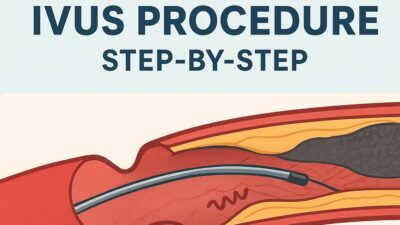Heart diseases are rising rapidly in India and across the world, making early diagnosis and treatment very important. A Cardiac Catheterization Lab (Cath Lab) plays a vital role in detecting and treating various heart problems. People often ask, “What is a cardiac catheterization lab?”, “What labs are done before cardiac catheterization?”, or “Is cath lab angiography?” In this article, we will cover everything about cardiac catheterization procedure, types, indications, cost, and cath lab meaning.
What is a Cardiac Catheterization Lab?
A Cardiac Catheterization Lab, commonly called Cath Lab full form, is a specialized hospital room equipped with advanced imaging machines and technology. It is mainly used for:
- Diagnosing heart problems
- Performing cardiac catheterization procedure
- Treating blocked or narrowed arteries
- Inserting stents and pacemakers
Table of Contents
Cardiac Catheterization Procedure
Many people wonder, “How serious is a heart catheterization?” The truth is, it is a safe and minimally invasive procedure done by expert cardiologists.
Step-by-Step Process:
- Preparation – Basic blood tests and ECG are performed.
- Insertion – A thin flexible tube called a catheter is inserted through the groin or wrist artery.
- Imaging – Dye is injected, and X-ray images show blockages or narrowing in arteries.
- Treatment – If required, angioplasty or stent placement is done in the same procedure.
List of Procedures Done in Cath Lab
A list of procedures done in cath lab includes both diagnostic and therapeutic methods:
- Coronary angiography
- Angioplasty with stent placement
- Electrophysiology studies
- Pacemaker and ICD implantation
- Balloon valvuloplasty
- Rotablation for hard blockages
- Structural heart procedures like TAVR
These cath lab procedures are essential for patients with severe chest pain, heart attacks, or rhythm disorders.
Types of Cardiac Catheterization
There are different types of cardiac catheterization depending on the purpose:
- Diagnostic Catheterization – To check blood flow and heart structure.
- Interventional Catheterization – For treatments like angioplasty or valve repair.
- Electrophysiology Studies – To detect abnormal heart rhythms.
- Right Heart Catheterization – To measure pressures in heart chambers.
Cardiac Catheterization Purpose
The cardiac catheterization purpose is both diagnostic and therapeutic. It helps:
- Detect blocked arteries
- Measure oxygen levels in blood
- Evaluate pumping function of the heart
- Repair or open narrowed vessels
- Plan further treatment like bypass surgery
Cardiac Catheterization Indications
Doctors recommend this procedure in the following situations:
- Severe chest pain (angina)
- Heart attack (acute myocardial infarction)
- Suspected coronary artery disease
- Abnormal stress test results
- Heart valve disease
- Congenital heart defects
So, cardiac catheterization indications are crucial for timely diagnosis and treatment.
What Labs are Done Before Cardiac Catheterization?
Before the procedure, doctors perform some important tests:
- Blood sugar and kidney function tests
- ECG and echocardiography
- Blood clotting profile
- Chest X-ray
Is Cath Lab Angiography?
Yes, angiography is one of the most common cath lab procedures. It uses dye and X-ray imaging to visualize coronary arteries. However, the cath lab is also used for many other interventions, not just angiography.
What is a Cath Used For?
A cath (catheter) is used for:
- Delivering dye for imaging
- Opening blocked arteries
- Inserting pacemakers
- Measuring pressure inside the heart
Cath Lab Staff: Nurses and Technicians
A cath lab nurse helps with patient care, monitoring vital signs, and assisting the cardiologist.
A cath lab technician operates imaging machines, prepares instruments, and ensures smooth procedure flow.
Together, they play a key role in saving lives
How to Work in a Cardiac Cath Lab?
- For cath lab nurse – Nursing degree + cardiology training
- For cath lab technician – Diploma or degree in cardiac technology
- Hands-on training in handling equipment and assisting doctors
Cath Lab Price in India
The cath lab price depends on the hospital, city, and procedure type.
- Diagnostic angiography: ₹10,000 – ₹25,000
- Angioplasty with stent: ₹1.2 – ₹2.5 lakh
- Pacemaker implant: ₹1.5 – ₹3 lakh
Searching cath lab near me on Google will help patients find the nearest center and cost details.
Risk Factors and Safety
While cardiac catheterization procedure is generally safe, risks include:
- Bleeding at catheter site
- Allergic reaction to dye
- Arrhythmias (irregular heartbeat)
- Very rare chance of stroke or heart attack
Doctors carefully check the cardiac catheterization indications and patient condition before recommending it.
Cardiac Catheterization PDF for Students
For students and medical professionals, many hospitals and institutes provide cardiac catheterization pdf with detailed diagrams, procedures, and guidelines. These are helpful for training and research purposes.
FAQs on Cath Lab
1. What is a cardiac catheterization lab?
It is a hospital room with imaging machines used for heart diagnosis and treatment.
2. What labs are done before cardiac catheterization?
Blood tests, ECG, kidney tests, and chest X-rays are common.
3. How serious is a heart catheterization?
It is safe and minimally invasive but must be done by experts.
4. Is cath lab angiography?
Yes, but angiography is only one of many procedures done in a cath lab.
5. How to work in a cardiac cath lab?
One needs nursing or cardiac technology training and practical experience.
6. What is a cath used for?
It is used for dye injection, artery opening, pacemaker insertion, and pressure measurement.
7. What is cath lab full form?
Cath Lab = Cardiac Catheterization Laboratory.



